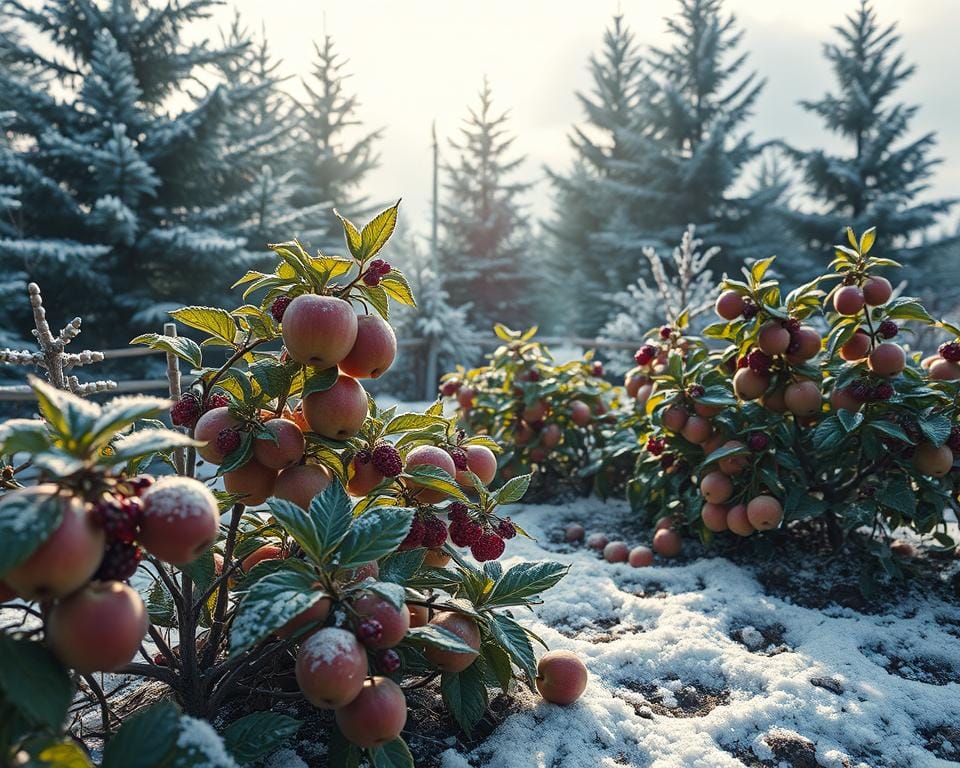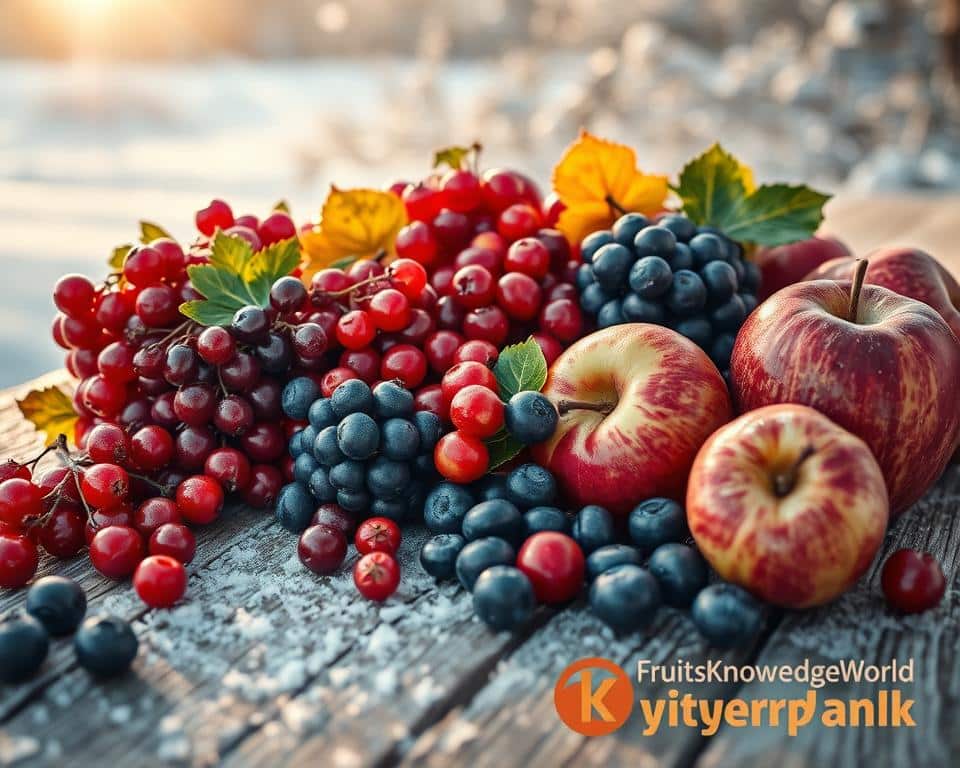Many think their gardening choices are few in cold climates. Yet, there are plenty of cold-hardy fruits that grow well even in very cold weather. If you love permaculture gardening and want a garden full of variety and productivity, this guide has great tips for fruits that do well in the cold.
Gardening in colder places isn’t just about zone 3 fruit trees like apples and crabapples. You can also grow unique and rewarding fruits such as Cornelian cherries, lingonberries, and spicebush. Alongside the usual apples and pears, these fruits show that even in tough conditions, like the freezing winters of zone 4, you can have a successful harvest.
By using sustainable orchard management principles, you can find new ways to garden. This advice helps you try out imaginative gardening techniques. It shows you can go beyond what you thought was possible in your cold climate gardens.
Key Takeaways
- Many varieties of cold-hardy fruits can thrive in cold climates, providing extensive gardening options.
- Embrace permaculture gardening principles to achieve a productive and sustainable garden.
- Explore less common fruits like Cornelian cherries and lingonberries for diverse planting.
- Cold climate fruits can demonstrate remarkable resilience, even in harsh winters of zone 4.
- Innovative growing techniques can help you manage and protect your sustainable orchard.
- Understanding your specific zone can significantly enhance your gardening success.
Introduction to Cold Climate Gardening
Starting a garden in a cold climate opens exciting doors and challenges. Knowing which resilient fruit species to grow is key, especially for zones 3, 4, and 5. Choose cold-hardy plants like apples and aronia berries. These choices push you to find new and tasty options beyond what you see in stores.
Cold climate gardening also lets you dive into zone 4 permaculture. You get to grow edibles such as edible blue honeysuckle that stand up to cold. These plants add variety to your meals and make your garden tough against the frost.
Good gardening in cold areas needs careful planning. Improving soil by adding organic matter helps drainage and fertility. Starting seeds inside or in greenhouses extends your season. Plants like snowdrops and primroses are frost-resistant, making them great choices for chilly gardens.

Keeping your plants safe from cold is crucial. Use tree wraps, row covers, and cold frames to boost growth. It’s vital to keep an eye on soil moisture to prevent damage in winter. With the right care, your cold climate garden can flourish and bring joy.
| Plant Type | Resilient to | Optimal Zones |
|---|---|---|
| Blue Honeysuckle | Subzero Temperatures | 3-5 |
| Apple Trees | Frost | 3-5 |
| Aronia Berries | Below Freezing | 3-5 |
| Primroses | Winter Frost | 4-7 |
| Strawberry Plants | Cold Temperatures | 3-10 |
Doing well in cold climate gardening means mastering the balance of weather and garden care. By choosing the right fruits, managing your soil, and protecting plants, you turn cold weather from a problem into a chance for a lush garden.
Cold Climate Fruits: Examples and Tips
Growing fruits in cold climates can be highly rewarding. This section shares tips on apples, aronia, and blueberries. You’ll learn how to grow these nutritious foods in USDA hardiness zones 3 to 9.
Apples & Crabapples (Malus sp.)
Apples are tough and survive cold winters in zones 3 to 4. The Dolgo crabapple is notable for its sweet fruits and beautiful flowers. Crabapples can make your garden diverse and attract pollinators. Plant them between November and March for best results.

Aronia Berries (Aronia melanocarpa)
Aronia berries, or chokeberries, are loaded with antioxidants. They grow well in zones 3 to 9. These berries are easy to grow and offer lots of fruit. Plant aronia in early spring to watch them thrive.
Blueberries (Cyanococcus)
Blueberries need little care and live long. They fit well in zones 3 to 9 and adjust to different soils. For best growth, keep the soil acidic and water well. Blueberries are easy to grow and offer delicious fruit.
Growing Techniques for Success
In cold climates, fruit gardening needs special growing methods. These improve how strong your plants are and how much they produce. We will look at key ways to make your trees do well, even when it’s chilly.
Mulching and Soil Preparation
Effective mulching and preparing the soil are key for healthy fruit trees in cold areas. Winter mulching keeps the soil temperature steady and keeps moisture in. This stops roots from getting damaged in freezing winters. The soil should get better with high-quality soil changes for growth. Adding organic compost or rotted manure helps roots grow better. It keeps the tree strong during the growing season.
Mulching also stops frost damage, lessens weeds, and keeps the soil in good shape. Spread organic mulch—like wood chips, straw, or leaves—around the base of the tree. This protects the roots from big temperature changes.
Tree Wrapping and Protection
Wrapping trees is important to keep young trees safe in winter. Use materials like burlap or tree wrap to stop bark damage from frost cracking. This also keeps rodents from eating the bark in severe winters.
Building windbreaks or placing trees in areas protected from wind cuts down cold wind damage. Using mulch and eco-friendly wraps helps trees stay strong without harming the environment.
| Protection Technique | Benefits |
|---|---|
| Winter Mulching | Regulates soil temperature, retains moisture, and prevents root damage |
| Soil Amendments | Improves nutrient availability and supports root development |
| Tree Wrapping Methods | Prevents bark injury and protects from rodents |
| Windbreaks | Reduces cold wind impact and supports tree growth |
Using these methods, your fruit trees will be ready for cold weather. They will give a lot of fruit. Regular care and protection make your orchard strong and fruitful.
Popular Cold Hardy Fruit Varieties
In the world of gardening, some fruits stand up to the cold better than others. For those who love to garden in cooler climates, Honeycrisp apples, Montmorency cherries, and Superior plum trees are perfect. Each of these fruit varieties brings something special to the table, both in taste and in how they grow.
Honeycrisp Apples (Malus ‘Honeycrisp’)
Honeycrisp apples are loved for their sweet flavor and crunch. They’re tough against the cold and do best in zones 4 and up. These trees need plenty of sun, about 6-8 hours a day, to do well. You won’t wait long for fruit, as they start producing in 3-6 years.
Montmorency Cherries (Prunus cerasus ‘Montmorency’)
When people think of cherry pies, they often think of Montmorency cherries. They’re very cold-hardy and thrive in low temperatures better than other cherries. For lots of cherries, make sure they get full sun and the soil drains well. Planting more than one helps with pollination and increases your cherry haul.
Superior Plum Trees (Prunus ‘Superior’)
Superior plum trees produce beautiful and tasty fruit and are ideal for colder areas. Like the apples and cherries, they’re happy in zones 4 and up. Start them off with lots of water and keep them fed with regular fertilizer. Although they take a little time to fruit, about 3-6 years, they are very dependable once they start.
| Fruit Variety | Cold Hardiness Zone | Sunlight Requirement | Time to First Harvest |
|---|---|---|---|
| Honeycrisp Apples | 4 and above | 6-8 hours | 3-6 years |
| Montmorency Cherries | 4 and above | 6-8 hours | 3-6 years |
| Superior Plum Trees | 4 and above | 6-8 hours | 3-6 years |
Conclusion
Growing a successful orchard in cold climates mixes knowledge, patience, and planning. We’ve seen that fruits like apples, blueberries, and plums thrive in the cold and reward you with plenty of produce. By using sustainable practices and effective cultivation techniques, your orchard can succeed, even in the toughest winters.
To do well, you need to know the cold hardiness of each fruit. For example, peaches can handle up to -25°C, while tart cherries manage around -18°C. But, quick temperature changes can harm these trees. Dr. Ioannis Minas’ research on peach cold tolerance is crucial for your planning. This means keeping a close eye on your trees and using protection like wraps and mulch is key.
With climate change affecting growing conditions, adapting is essential. Planting resistant varieties or using protection methods can help. Let this guide motivate you to tackle the challenges of winter homesteading. See cold weather as a chance for your orchard to grow strong and productive.



